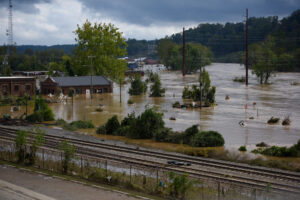Just In: Helene Kills 64, Submerges Historic Village; Hundreds of Roads Closed in North Carolina
![]()
In a devastating turn of events, Tropical Storm Helene has left a trail of destruction across North Carolina, claiming at least 64 lives and submerging the historic riverside village of Ashton’s Ferry under several feet of water. The catastrophic flooding, described by meteorologists as “a once-in-a-century event,” has displaced thousands of residents, crippled infrastructure, and closed over 400 roads statewide.
The storm made landfall late Tuesday evening near Wilmington as a high-category tropical system, with sustained winds topping 85 mph and record-breaking rainfall that continued for over 36 hours. Entire communities were inundated in mere hours. The hardest-hit area, Ashton’s Ferry, a 200-year-old town known for its colonial architecture and scenic views of the Roanoke River, now lies underwater. Rescue teams arriving by boat found houses half-submerged, streets transformed into canals, and stunned residents waiting on rooftops for help.

Governor Alicia Burnham declared a state of emergency early Wednesday morning, mobilizing the National Guard and calling for federal disaster assistance. “This is a moment of great tragedy for our state,” she said during a press briefing. “We are committed to deploying every available resource to save lives, restore critical services, and begin rebuilding.”
Emergency response efforts have been focused primarily on rescue and evacuation. Over 3,000 people have been rescued so far, many of them airlifted by Coast Guard helicopters. Shelters in Raleigh, Durham, and Fayetteville are at capacity, with more being established in school gymnasiums and community centers. Officials are urging anyone who can evacuate to do so immediately, as water levels continue to rise in certain flood basins.
The death toll, initially reported at 17, rose sharply over the past 24 hours as search and recovery teams gained access to previously unreachable areas. Many of the victims drowned in their homes or vehicles as waters rose faster than forecasted. One family of five in Edgecombe County perished after attempting to cross a washed-out bridge. Local officials reported that communication failures and power outages further complicated early warning efforts.
Infrastructure damage across the state is extensive. Over 400 roads, including major arteries like Interstate 40 and U.S. Route 70, remain impassable due to flooding, debris, or collapse. The Department of Transportation has reported dozens of washed-out bridges and sinkholes. Crews are working around the clock to clear debris and assess structural safety.
In Ashton’s Ferry, where the river crested at an unprecedented 32 feet, residents mourn not only the loss of homes but also irreplaceable heritage. The town’s 18th-century courthouse and museum are believed to have sustained irreversible damage. “We’ve lost a piece of North Carolina’s soul,” said Sarah Tilling, a local historian. “The history that was preserved here for generations may be gone forever.”
Utility outages have also compounded the crisis. Over 1.2 million customers are without electricity, and boil-water advisories have been issued across 14 counties. Cell service remains spotty in rural areas, making coordination difficult for emergency responders.

Environmental concerns are emerging as well. Floodwaters have breached several containment ponds at industrial facilities and hog farms, raising fears of water contamination. The North Carolina Department of Environmental Quality is monitoring the situation closely, particularly near the Tar and Neuse rivers. Experts warn that bacteria, sewage, and chemical runoff could pose a secondary public health risk in the coming days.
Federal assistance is on the way. President Franklin authorized a major disaster declaration for North Carolina late Wednesday, unlocking federal funds for recovery. FEMA teams have begun arriving to assess damage and coordinate long-term relief efforts.
Helene has since weakened to a tropical depression and is moving northeast, but forecasters warn that more rain is expected through the weekend, particularly in already saturated areas. Flash flood watches remain in effect across eastern and central North Carolina.
For now, residents are left to grapple with the scale of loss and the uncertainty ahead. “We’ve been through hurricanes before,” said James Carter, a lifelong Ashton’s Ferry resident. “But nothing like this. We don’t even know where to start.”
With climate scientists warning of stronger and more frequent storms due to global warming, Helene could mark a turning point in how North Carolina prepares for future natural disasters. For now, recovery is the priority — and the road ahead, quite literally, remains flooded.
—
Emergency Hotlines:
Evacuation & Rescue Assistance: 1-800-774-HELP
Shelter Locations & Resources: www.ncdps.gov/helene-response
Report Missing Persons: 1-866-FIND-NC1
Donations: Organizations like the Red Cross, United Way, and local food banks are accepting donations to aid displaced families.













